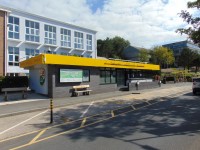Access Guide
Introduction
- This is a route from the Main Campus Reception to the Old College.
- This route uses the TrawsCymru T2 bus service to reach the Aberystwyth Bus Station and Alexandra Road, Chalybeate Street, Queen Street, Great Darkgate Street, Castle Street and King Street.
- This route is approximately 1.8km and takes around 15 minutes to complete.
- The main hazards on this route are steep slopes, uncontrolled road crossings and heavy traffic during rush hours.
Campus Reception to University Bus Stop
- Exit the Campus Reception to the right and head out of the campus.
- The pavement has an even, level, tarmac surface.
- The pavement takes a slight gradient as you approach the A487 road.
- As you reach the A487 turn left to cross the university entrance road.
- This crossing has tactile paving and dropped kerbs on both sides with a level central island with tactile paving.
- This crossing is shown in photographs 4, 5 and 6.
- Head straight down the hill along the pavement.
- The path has an even, tarmac surface with a steep gradient.
- The university bus stop is approximately 30m along the pavement on the left.
- This is a sheltered bus stop with access points, 95cm wide at each end and bench seating inside.
- The bus stop is shown in photographs 8, 9 and 10.
- This bus stop provides access to the Aberystwyth Bus and Train Station via bus routes 3, 512, T2, T5, T28 and YP24.
Aberystwyth Bus and Train Station to Queens Street Crossing
- Exit the bus station from the south west side, in front of the train station.
- The pavement in this area has an even and level stone slab surface.
- There is low level bench seating available in this area.
- There are bollards with 2m separation between the pavement area in front of the train station and the bus station, as shown in photograph 2.
- Proceed to the traffic light crossing on the right of the pavement in front of the train station.
- This crossing is traffic light controlled with tactile paving and dropped kerbs on both sides.
- The traffic light controlled box 98cm high and has an audible warning with a rotating warning cone.
- Turn left on to Alexandra Road.
- The pavement in this area has an even and level stone slab surface.
- There is a lamppost in the centre of the pavement approximately 10m from the crossing.
- After approximately 15m the pavement narrows.
- There are sandwich boards and advertising signs along the right side of the pavement.
- Cross Union Street.
- This crossing has tactile paving and dropped kerbs on both sides.
- This crossing is shown in photographs 8 and 9.
- A lamppost on the far side of the crossing narrows the pavement to 155cm on the right and 80cm on the left.
- Continue straight along Alexandra Road.
- The pavement in this area has an even and level stone slab surface with metal plates and stone cut guttering set in the pavement.
- The pavement bears around to the right to head up Chalybeate Street.
- There are bollards along the left edge of the pavement.
- There are signs spread across the main thoroughfare of this area of the pavement.
- The pavement has a slight gradient leading up into the corner of Alexandra Road and Chalybeate Street.
- Once around the corner turn left to cross Chalybeate Street.
- This crossing has tactile paving and dropped kerbs on both sides.
- This crossing is shown in photographs 15 and 16.
- Turn right after crossing Chalybeate Street.
- The pavement here has an uneven and level brick block surface.
- After approximately 5m the pavement narrows and becomes even with a concrete tile surface.
- Cross Queens Street.
- There is tactile paving and dropped kerbs on both sides of the crossing.
- Traffic is one way on Queens Street and will be coming from the left only.
- This crossing is shown in photographs 19 and 20.
Queens Street Crossing to Great Darkgate Street
- After crossing Queens Street turn left.
- The pavement on this street has and uneven, concrete tile surface with a slight gradient.
- There is a signpost on the corner leaving 120cm clearance on the pavement.
- Approximately 5m along Queen Street there is a bollard on the left leaving 135cm.
- There are frequent manhole covers and ridged stone guttering along the pavement.
- The pavement width varies from 115cm to 140cm.
- Cross the car park access road approximately 95m along Queens Street.
- This crossing has dropped kerbs and tactile paving on both sides.
- Continue along Queens Street.
- The pavement on this street has an uneven, concrete tile surface with a slight gradient.
- Cross the two car park entrance approximately 120m along Queens Street.
- This crossing is 21m long with a central island with level tactile paving.
- This crossing has dropped kerbs and tactile paving on both sides.
- This crossing is shown in photographs 10, 11, 12 and 13.
- Continue along Queens Street.
- There is a lamppost on the far side of the crossing with 63cm clearance on the left and 75cm clearance on the right.
- The pavement continues at a width of 95cm.
- Cross Bridge Street.
- This crossing has tactile paving and dropped kerbs on both sides.
- This crossing is shown in photographs 16, 17 and 18.
- Turn right after crossing Bridge Street.
- The pavement here has a level and even concrete slab surface, 80cm in width.
- Turn left on to Great Darkgate Street.
Great Darkgate Street to The Old College
- Great Darkgate Street has an even and level concrete tile path with a width of 125cm.
- Cross the semi pedestrianised section of Great Darkgate Street to the far side.
- This area is level with brick gutters.
- Pedestrians have right of way in this area.
- This area is shown in photographs 1, 2, 3 and 4.
- Turn right at the end of the Great Darkgate Street pedestrianised area on to Castle Street.
- Castle Street has an even tarmac surface with a slight gradient and a width of 105cm.
- This area is shown in photographs 5, 6, 7 and 8.
- At the Castle Street junction with New Street, cross the junction continuing ahead.
- Cross New Street using the tactile paving on the left of pavement and the dropped kerb approximately 10m down the far right side of the junction on Castle Street.
- This crossing is shown in photographs 9, 10 and 11.
- This section of Castle Street has a level tarmac surface with a slight gradient and a width of 110cm.
- Exit into the street using the dropped kerb approximately 15m from the end of Castle Street and cross to the far side of the road and proceed to the junction.
- Turn left onto the pavement on King Street.
- There is a dropped kerb with no tactile paving here.
- This section of pavement was closed at the time of the survey.
- Proceed along King Street.
- This area has an even and level tarmac surface.
- After approximately 15m turn right to cross King Street.
- This crossing has tactile paving and dropped kerbs on both sides.
- This crossing is shown in photographs 17 and 18.
- Turn left after crossing and continue along King Street to the Old College main entrance.
- The pavement in this area has an even and level stone and concrete tile surface.



